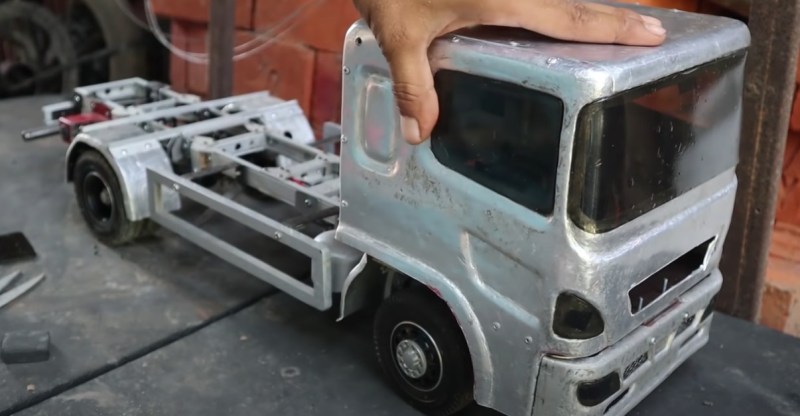These days you can get just about any kind of radio controlled vehicle as a ready-to-run model. Cars, trucks, excavators, you name it. Open the box, charge the batteries, and you’re ready to roll. Even with all these modern conveniences, there is still a special breed of modelers who create their own models using only a few off-the-shelf parts.
[Rini Anita] is exactly that rare breed, creating this aluminum RC truck from scratch. The truck itself is a cab-over — short for Cab Over Engine (COE), a style seen making local deliveries worldwide. He starts with the ladder frame chassis, which is constructed using an extruded aluminum channel. This is the same material you’d normally use for the door tracks in retail store display cases. The electronics and standard RC fare: a receiver, electronic speed control, and a servo for steering. Batteries are recycled lithium cells. The main gearbox and drive axle look to be sourced from another RC vehicle, while leaf springs and suspension components are all custom built.
The truck’s body is a great example hand forming metal. First, a wooden form was created. Sections for the windows and door panels were carved out. Sheet aluminum was then bent over the wood form. Carefully placed hammer blows bend the metal into the carved sections – leaving the imprints of doors, windows, and other panel lines.
Throughout this build, we’re amazed by [Rini]’s skills, and the fact that the entire job was done with basic tools. A grinder, an old drill press, and a rivet gun are the go-to tools; no welder or 3D printer to be found. This puts a project like this well within the means of just about any hacker — though it may take some time to hone your skills! For his next truck, maybe [Rini] can add a self driving option!















Wow. This is a labor of love for sure. Very impressed! Though I had to laugh at 24:42. I’m surprised the scissors survived cutting both wires at the same time (shorts out the battery pack!). I made that mistake once, and once was all the education I needed to never, ever do it again! My batteries were capable of a few more orders of magnitude more short-circuit current than these though.
I once cut a live 120V AC line with a pair of diagonal cutters. POW! Took a chunk out of one of the blades.
We call those exploded in the ‘biz and it’s time to give the set of pliers/cutters away to an apprentice before the bad luck on them finds us again
I Don’t know. On a 230V system in the UK, if you cut it juuuuust right….. It creates a lovely, round, beveled edge that ends up perfect for stripping solid core cable. Nowadays manufacturers put those in on fancy side cutters. In my day we had to make them ourselves ^_~
You and my boss. Super Champs, blow a hole through both cutters.
No engine, but a friend built this 1:1 scale yellow cab by hand from alu haha: https://m.youtube.com/watch?v=rY8BfddjeCo
I can’t be the only one imagining what it feels like when that thing runs into your shins…
Not only is [Rini] a master metalsmith, he is also a master material scrounger!
What an amazing build, a master class on upcycling!
Terrifying to watch someone solder lithium cells which may have a thermal runaway temperature about 20 degrees below where solder melts. Tickling the dragon’s tail there.
I only winced at the shrunk wrapped cells being held against raw metal edges, could have used some more of the tape he used on the ends of the pack.. Otherwise solid build. I just saved 3 out of 4 cells from an old laptop as well (actually 6 out of 8 cells, but it was a 4s pack same as his, just 2p)
I found the rubber strips or flip flop used to beat aluminum into a wood mold intriguing, wonder if that historically was done with leather. He has a real coach-built lorry.
When the title said “from scratch” I kind of expected he would also wire the electrical motor by himself, melt his own copper cables, as well as create the battery from lithium ore. But hey, hacking isn’t what it used to be.
“If you wish to make an apple pie from scratch, you must first invent the universe”
– Carl Sagan
Cool build but ELEVEN ads in the video? Come on man.